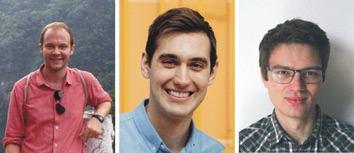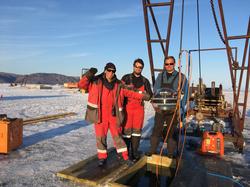News Archive 2016 / 2017
- At the 2017 MANTS Meeting (October 2017 in Marseille), Uli Katz (ECAP, University Erlangen-Nürnberg) took over from Christian Spiering (DESY) as the chair of the GNN Board. Christian had chaired the board for four years, starting from its formation in 2013.
For the upcoming two-year term, the board members arePaschal Coyle (CPPM, Marseille, France)
Zhan Djilkibaev (INR Moscow, Russia)
Grigorij Domogatsky (INR Moscow, Russia)
Darren Grant (University Alberta, Alberta, Canada)
Albrecht Karle (Univ. Wisconsin, Madison)
Uli Katz - chair (ECAP, Univ. Erlangen-Nürnberg, Germany)
Antoine Kouchner (APC/University Paris, France)
Christian Spiering (DESY, Zeuthen, Germany)
Maurizio Spurio (Univ. Bologna/INFN, Bologna, Italy)
Mauro Taiuti (Univ. Genova/INFN, Genova, Italy)
Shigeru Yoshida (Chiba University, Chiba, Japan)
- The 2017 GNN dissertation prize is awarded to three winners:
Stefan Coenders (Technical University Munich) for his thesis "High-energy cosmic ray accelerators: probing seven years of IceCube muon data for time-integrated emission of point-like neutrino sources"
Ryan Maunu (University of Maryland) for his thesis "A search for muon neutrinos in coincidence with Gamma-Ray Bursts in the Southern hemisphere sky using the IceCube neutrino observatory"
Jannik Hofestädt (ECAP) for his thesis "Measuring the neutrino mass hierarchy with the future KM3NeT/ORCA detector"

-
The 2017 winter expedition of Baikal GVD started at February 18, with the first group of technicians and physicists reaching the site and beginning to deploy equipment on the ice. At March 31, the main goal of the expedition has been achieved: the replacement of outdated electronics modules in 3 of the 24 sections of the first cluster and the deployment of the full second cluster. The official end of the expedition was April 14, when only shift personnel stayed in the shore station.
The picture shows the very last optical module of cluster 2, just before lowering the full string, at March 31.
-
The 2016 GNN Dissertation Prize was awarded at the MANTS
Meeting in Mainz, at October 1, to three winners:
Lars Mohrmann (DESY Zeuthen) for his thesis “Characterizing Cosmic Neutrino Sources (A Measurement of the Energy Spectrum and Flavor Composition of the Cosmic Neutrino Flux Observed with the IceCube Neutrino Observatory)"
Agustín Sánchez Losa (IFIC Valencia) for his thesis “Search for high energy cosmic muon neutrinos from variable gamma-ray sources and time calibration of the optical modules of the ANTARES telescope”
Chris Weaver (University of Wisconin, Madison) for his thesis “Evidence for Astrophysical Muon Neutrinos from the Northern Sky"
This year's GNN Prize was sponsored by APPEC.

- In March/April, the first cluster of the GVD neutrino telescope in Lake Baikal has been upgraded to its baseline configuration, with 288 optical modules (OMs) arranged on eight vertical strings. The former array was enlarged from 24 to 36 OMs per string, covering depths from 765 m to 1290 m. The seven side strings were moved from a 40 m radius to 60 m distance around the central string. The instrumented water volume of this “Dubna” cluster is now about 5.9 Mtons. The array was commissioned in early April 2016 and takes data since then. All but two of 24 sections work perfect, the problems with the remaining two sections are under investigation. Moreover, in preparation of the next year’s season, a new electro-optical cable was laid which will connect a second cluster with the shore.
- KM3NeT on ESFRI roadmap
At 10 March 2016, the European Strategy Forum for Research Infrastructures (ESFRI) announced that KM3NeT 2.0 is among the 21 projects selected for the 2016 ESFRI Roadmap.
To be eligible, a project must have at least three countries with funding committment and political support and must pass a rigorous selection process with respect to to scientific excellence, pan-European relevance, socio-economic impact, e-needs and maturity level, These are wonderful news, not only for KM3NeT but also for the full GNN community.
See more at KM3NeT.
- The members of the Global Neutrino Network congratulate their colleagues from the LIGO collaboration to their fantastic success - the discovery of gravitational waves.
Physicists from IceCube and ANTARES checked whether these detectors had registered an excess of neutrinos coinciding in time with the signal reported by LIGO. No coincident neutrinos were observed, neither by IceCube nor by ANTARES.
This is a centennial success for gravitational physics, but also a detective story of neutrino physics, which just started and will be continued for the following gravitational wave detections.
-
At Thursday, January 28, 2016, the KM3NeT collaboration
posted the letter of Intent for KM3NeT 2.0 on arXiv:1601.07459The two major scientific goals of KM3NeT 2.0 are the discovery of astrophysical sources of neutrinos with the KM3NeT/ARCA detector and the measurement of the neutrino mass hierarchy using atmospheric neutrinos with the KM3NeT/ORCA detector.
After the successful deployment of a first string of ARCA in December last year, this marks the next major milestone of the way towards KM3NeT!
See also the press release



